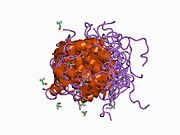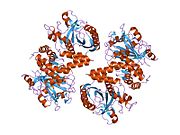Band 3 anion transport protein
Ensembl | |||||||||
|---|---|---|---|---|---|---|---|---|---|
| UniProt | |||||||||
| RefSeq (mRNA) | |||||||||
| RefSeq (protein) | |||||||||
| Location (UCSC) | Chr 17: 44.25 – 44.27 Mb | Chr 11: 102.24 – 102.26 Mb | |||||||
| PubMed search | [3] | [4] | |||||||
| View/Edit Human | View/Edit Mouse |
| solute carrier family 4 (anion exchanger), member 1, adapter protein | |||||||
|---|---|---|---|---|---|---|---|
Chr. 2 p23.3 | |||||||
| |||||||
Band 3 anion transport protein, also known as anion exchanger 1 (AE1) or band 3 or solute carrier family 4 member 1 (SLC4A1), is a protein that is encoded by the SLC4A1 gene in humans.
Band 3 anion transport protein is a
Function
Band 3 is present in the basolateral face of the α-intercalated cells of the collecting ducts of the nephron, which are the main acid-secreting cells of the kidney. They generate hydrogen ions and bicarbonate ions from carbon dioxide and water – a reaction catalysed by carbonic anhydrase. The hydrogen ions are pumped into the collecting duct tubule by vacuolar H+ ATPase, the apical proton pump, which thus excretes acid into the urine. kAE1 exchanges bicarbonate for chloride on the basolateral surface, essentially returning bicarbonate to the blood. Here it performs two functions:[citation needed]
- Electroneutral chloride and bicarbonate exchange across the plasma membrane on a one-for-one basis. This is crucial for CO2 uptake by the red blood cell and conversion (by hydration catalysed by carbonic anhydrase) into a proton and a bicarbonate ion. The bicarbonate is then excreted (in exchange for a chloride) from the cell by band 3.
- Physical linkage of the plasma membrane to the underlying membrane skeleton (via binding with ankyrin and protein 4.2). This appears to be to prevent membrane surface loss, rather than having to do with membrane skeleton assembly.
Distribution
It is ubiquitous throughout the
- the erythrocyte(red blood cell) cell membrane and
- the collecting duct of the kidney.
Gene products
The erythrocyte and kidney forms are different
The erythrocyte isoform of AE1, known as eAE1, is composed of 911 amino acids. eAE1 is an important structural component of the erythrocyte cell membrane, making up to 25% of the cell membrane surface. Each red cell contains approximately one million copies of eAE1.[citation needed]
The kidney isoform of AE1, known as kAE1 (which is 65 amino acids shorter than erythroid AE1) is found in the
Clinical significance
Mutations of kidney AE1 cause distal (type 1)
Mutations of erythroid AE1 affecting the extracellular domains of the molecule may cause alterations in the individual's blood group, as band 3 determines the Diego antigen system (blood group).[citation needed]
More importantly erythroid AE1 mutations cause 15–25% of cases of
Interactions
Band 3 has been shown to
Discovery
AE1 was discovered following SDS-PAGE (sodium dodecyl sulfate polyacrylamide gel electrophoresis) of erythrocyte cell membrane. The large 'third' band on the electrophoresis gel represented AE1, which was thus initially termed 'Band 3'.[14]
See also
References
- ^ a b c GRCh38: Ensembl release 89: ENSG00000004939 – Ensembl, May 2017
- ^ a b c GRCm38: Ensembl release 89: ENSMUSG00000006574 – Ensembl, May 2017
- ^ "Human PubMed Reference:". National Center for Biotechnology Information, U.S. National Library of Medicine.
- ^ "Mouse PubMed Reference:". National Center for Biotechnology Information, U.S. National Library of Medicine.
- PMID 19448077.
- PMID 3461480.
- S2CID 23554234.
- PMID 1722314.
- PMID 11606574.
- PMID 9774471.
- PMID 11063570.
- PMID 10820026.
- PMID 11994299.
- ISBN 0815332181.
Further reading
- Tanner MJ (1993). "Molecular and cellular biology of the erythrocyte anion exchanger (AE1)". Semin. Hematol. 30 (1): 34–57. PMID 8434259.
- Chambers EJ, Askin D, Bloomberg GB, Ring SM, Tanner MJ (1998). "Studies on the structure of a transmembrane region and a cytoplasmic loop of the human red cell anion exchanger (band 3, AE1)". Biochem. Soc. Trans. 26 (3): 516–20. PMID 9765907.
- Inaba M (2002). "[Band 3: expanding knowledge on its functions]". Seikagaku. 73 (12): 1431–5. PMID 11831035.
- Tanner MJ (2002). "Band 3 anion exchanger and its involvement in erythrocyte and kidney disorders". Curr. Opin. Hematol. 9 (2): 133–9. S2CID 30536102.
- Shayakul C, Alper SL (2004). "Defects in processing and trafficking of the AE1 Cl−/HCO3− exchanger associated with inherited distal renal tubular acidosis". Clin. Exp. Nephrol. 8 (1): 1–11. S2CID 5671983.
External links
- Diego blood group system at NIH
- Band+3+Protein at the U.S. National Library of Medicine Medical Subject Headings (MeSH)
- Chloride-Bicarbonate+Antiporters at the U.S. National Library of Medicine Medical Subject Headings (MeSH)
- Human SLC4A1 genome location and SLC4A1 gene details page in the UCSC Genome Browser.



